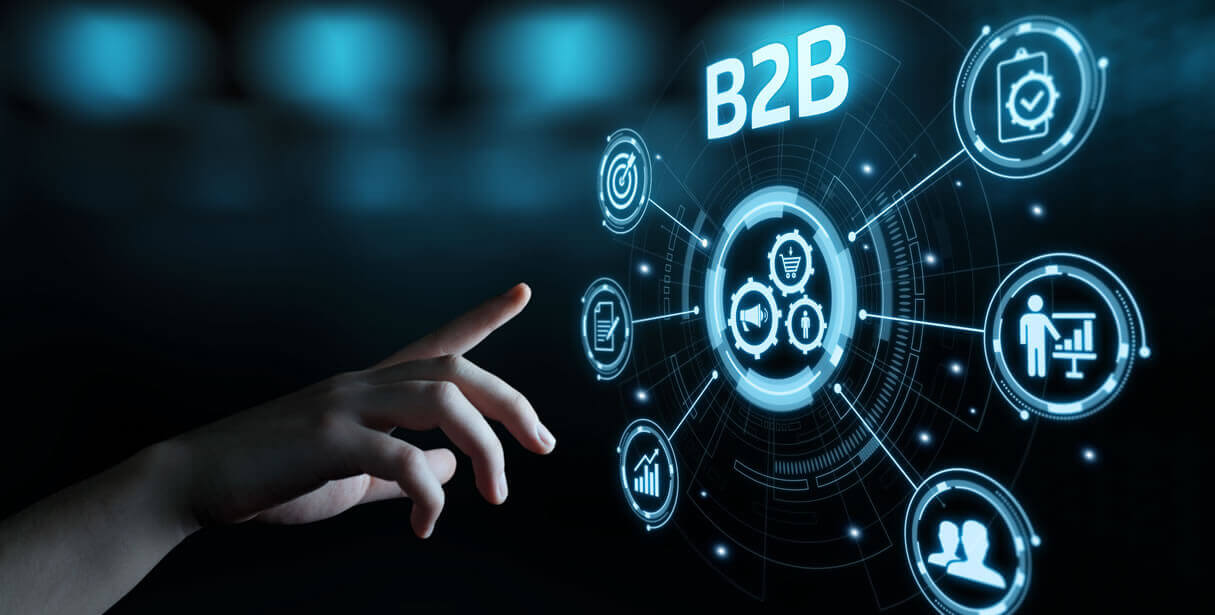27 Jan

As technology comes up with new ways to amaze us, we ultimately adapt to new habits. They become indispensable parts of our lifestyle too. The same goes for B2Bs and the way they make commerce now. The product and services adapt to the demands of customers, which are shaped by new technology. So how do you fit it? In this article, in other words, our B2B eCommerce guide, we’ll talk about what B2B eCommerce means briefly. You’ll also read about the most common misconceptions and mistakes about it, and how you can avoid these mistakes for your business.
Starting the B2B eCommerce guide with basics: What is B2B eCommerce?
B2B eCommerce is your regular B2B operations transferred to the online platform. It describes your business-to-business orders or other transactions that are made electronically.
As eCommerce makes it possible for you and your customer to carry out each transaction digitally, the experience is improved instantly. From wholesalers to distributors and to other B2B marketers, the buying efficiency is elevated. It also saves everyone money and time!
You can explore the on-stage operations for B2B eCommerce and how it transformed business for all B2B marketers, you can refer to our detailed article here.
Common B2B eCommerce Misconceptions and Pitfalls for B2B Marketers
It is safe to say that there are many ways in which B2B eCommerce is misinterpreted.
In this article, while exploring the idea of B2B eCommerce itself, we also aim to talk about these misconceptions as simplified as we can. Now let’s see what these misconceptions are:
1. Your product is not B2B
A lot of the time when a B2B marketer says they are not selling B2B, it’s because they do not understand that it is already B2B they are selling. As a B2B marketer, you first need to understand that selling comes in many forms in B2B. It could be wholesale, distribution to different sized retailers, working with organizations, or being the middle-man to sell to resellers. B2B selling does not dictate that you work as the supplier only. You will see that many online brands can be categorized as both B2B and B2C.
In relation to this, you do not need an eCommerce page dedicated to sell B2B. You can work on a single URL and generate site engagement over this while using customer groups to make a customized browsing experience for your B2B group.
2. Customers do not prefer online orders
The generation that was born into the years where cell phones were luxury is almost over. The new generation is all tech, and they are coming to managerial positions already. Even those that are not in managerial positions say that they are influential in purchasing decisions company-wide. Ultimately, B2B commerce is preferred online now, and it is not enough to have it online only.
And what do online purchasers want? Almost half of them think that with the self-service option, B2B eCommerce can be made easier. And the B2B executives agree that compared to just a few years ago, customers now wish to have customized experiences even more.
Millennials’ purchasing processes are quite different than those of their antecedents as well. They are more independent, and they are conscious when they are making purchasing decisions. They make their own research, and they do not rely on the words of a salesperson. They prefer peer opinions and market trends. They come in contact with a salesperson only after they are almost completely sure of the product they are buying.
So what does this mean to you as a B2B marketer? First of all, you need to have an established online presence. You need to make your presence visible by using the right online sales methods. And finally, you need to make sure that the service you are offering is a personalized one.
3. The belief that B2B eCommerce requires price transparency
Many brands do not want to share their prices publicly, with low margins and fierce rivals trying to undermine a B2B company. This is quite understandable, and that is why a customer can see the price only when they log in. You can leverage this by presenting your prices to your specific customers as negotiated.
In order to allow product exposure, you can still use your platform, but need clients who are not signed in to their customer groups (prospective) to call in to get rates.
4. Online ordering is not personal
We all know how offline businesses go. There is always a personalized aspect to it with phone calls, perks, and even visits. But the times are changing. So why not make your B2B eCommerce personalized?
It is actually not as difficult as you think. On the contrary, it is quite easy now. You can even get your orders to your phone if you want, and enhance the communication between your buyer and your brand. As studies show, instant communication is key to any online shopping experience. If you are there for your customer, they will be there for you to become loyal members of your client group as well.
5. The belief that an online store negates custom ordering
The potential for custom orders is far greater for B2B clients and wholesalers than with a B2C platform.
And they want to have custom orders for several B2B firms (which helps with that personal relationship).
With the help of custom quoting tools and segmented customer groups, it is possible for B2B marketers to send in a quote anytime they want. They can even assess the quote later on, and reply back if it works.
By using these tools, you can see the segment of the specific customer, so the next time they place an order they do not have to go over the process again. With that, you will be delivering speedy and personalized service that is made easy.
B2B eCommerce Guide Section for Marketing Basics
If you are on the verge of making your transition to B2B eCommerce, and still are in two minds, just remember that anything is possible to make your business prosper online. Does your customer require bulk ordering? That is possible. Do they need certain materials in specific sizes? Also manageable. Do you want to offer specified rates to a specific customer? You can do that too. You see, B2B eCommerce is there to nothing but elevate your business. Once you get to know it, you see how easy it is to carry out your business from one point too!
Here is a list of things you can do to grow your business and relationship with your B2B customers using B2B eCommerce.
- Get one step ahead of your competition by learning more about your sector, customer behaviors, and trends; educate your customers too!
- Get tech-savvy, and show your customers and yourself how you can save time and money.
- Eliminate the manual work with the use of technology, and save yourself from tiny errors that can cost you much.
- Invest all your extra time in customer success and loyalty.
- Get everyone in the team to have all the facts, and teach them scalability.
- Get more sales with reduced costs.
- Make eCommerce a component of your strategy but not your whole strategy.
- Reach out to your customers anytime, anywhere.
- Segment consumer interactions so that everyone feels the personalized touch.
1. Educate customers on products, features, and promotions
Having an online strategy that entails solid content and commerce is very useful.
Your content should provide all the necessary information to make an educated purchase. Or else, your customers will go to find it somewhere else.
Once you lose them, they are sure to find what they need and make the final purchase somewhere outside your business’ eCommerce channel.
As we mentioned above, B2B users have changed. And user experiences have changed alongside. Today, a complete B2B user experience means including extensive and important information and providing products and promotions to buyers. This is how B2B eCommerce works. When you provide such extensive information so your buyer can make an educated purchase, you show that you care. You also show that you are different than your competitors. Once you earn their trust, they will not seek the service anywhere else. They will always come back to you to make the final purchase – that is if they leave your site at all!
2. Take your B2B eCommerce business online
As we have mentioned time and time again in this article and many other articles on our blogs, the Millennials are now the buyers. They seek personalized experiences but that does not mean they want old-school one-on-one relationships.
While building your B2B eCommerce strategy, remember one thing: communication is key. So when you hit the road, make sure you keep the engagement going with your clients. You can implement technologies such as chat boxes or other web forms to keep your customers up-to-date with the services, promotions, and products that you provide. You can also add FAQ, how-to manuals as well as interactive navigation sections so that your users can find what they need on your site efficiently.
3. Make use of technology to overcome any difficulty
When compared to B2C or other businesses, B2B usually leaves almost no room for errors. One tiny mistake can cost you a lot because of the quantities you work with. So you need to meet the expectations, deliver on time and good quality and without any errors. What better way to use technology than that?
Make sure you use tools to synchronize all the details you have of a customer and a purchase. You can also use such tools to manage your inventory automatically, see all orders in customized categories, and track the fulfillment stages. This is sure to elevate your customer experience as well.
4. Launch promotions and loyalty programs to increase purchasing frequency.
Once you establish your digital presence, you need to keep looking for ways to improve it. As a B2B, you are likely to keep your stocks full all the time as there is continuous circulation. One way to make use of constant stock availability is to allow purchases subscription-based or one-off. This will help you collect important data that can eventually help you to offer personalized promotions or segment-based offers.
5. Align business processes and teams to scale.
Always make sure your internal teams are aligned with each other to overcome potential challenges and obstacles. You can achieve such alignment on a company scale by revising your company structure, reviewing the roles and resources, offering positions in case of organizational requirements, implementing a charter for organizational decisions that affect the digital team.
You can also opt to use online tools to drive sales by mobilizing the sales team. If online tools are not your cup of tea, you can always get professional support from firms such as Apex Loyalty to implement such measures and strategies for you.
6. Reduce costs, improve sales
It is important to have a digital presence but it is also almost equally important to know the kind of expenses it will produce. What is the roadmap for the commerce technology platform you selected and what does that mean for you in terms of its capacity? It is important to know and understand these details so that you can create your roadmap for your business too. You can get rid of certain maintenance and certification costs by understanding these details, and deciding what kind of technology that your business requires.
7. Implement a complementary eCommerce strategy
As a B2B, you need to get used to the idea of eCommerce, and how it elevates certain aspects of your business. Times are changing, and digital teams are very important for B2B businesses. In addition to sales leadership, the digital teams can showcase the advantages of consumers using technology-based customer self-service and how it can potentially help retire and meet targets for sales members. So you need to make sure that the customer can find the online service relevant to their needs in order to save them time, and earn you their trust.
8. Offer personalized services
It is important to offer services in a way that is user-friendly. Providing services but lacking in usability could cause you to lose your visitors instantly. In order to achieve this, you need to design your online services in a way that can get your customer to reach whatever they need in the easiest way possible. This can be done by using a responsive design that helps the customer navigate the website, manage their accounts, place orders, and manage anything across different devices.
9. Do not forget the business side of transactions
By now, you should already know that all your customers are unique. That’s why providing the unique eCommerce experience they deserve is essential. You can start doing this by building personalized relationships.
You can make use of segmentation to provide individual catalogs and rates, and other promotional programs to increase loyalty and business interactions with B2B loyalty programs. To run the process smoothly, you can come up with workflows that synchronize the B2B eCommerce system with your customer behaviors to streamline processes. Let’s say that your customers need an order approval process that has various steps. Then you need to make sure that your eCommerce platform can support this.
There are various tools that can make these possible for your business. If you want your business strategy to grow and grow your business with it, you can also prefer customized professional services that will work for your business.
We hope you enjoyed our brief introduction to B2B eCommerce and how to implement B2B eCommerce marketing for your business. You can always look for similar information on our Apex Loyalty blog. We are always here to offer our professional support for your company.
You can read our previous article from https://www.apexloyalty.com/the-role-of-ai-in-loyalty-programs/







